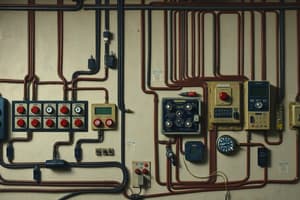Podcast
Questions and Answers
What tool is commonly used for bending, twisting, and crimping wires onto terminals in residential electrical installations?
What tool is commonly used for bending, twisting, and crimping wires onto terminals in residential electrical installations?
- Hammer
- Wire Stripper
- Lineman's Pliers (correct)
- Screwdriver
Which tool is essential for measuring electrical resistance, current, and voltage in electrical installations?
Which tool is essential for measuring electrical resistance, current, and voltage in electrical installations?
- Drill and Drill Bits
- Multimeter (correct)
- Screwdriver
- Electrician's Pocket Knife
What is the purpose of wire nuts in residential electrical installations?
What is the purpose of wire nuts in residential electrical installations?
- To connect wires together at a junction box (correct)
- To strip insulation from wires
- To measure electrical resistance
- To drill holes in walls for running electrical wires
What is the main function of a cable tester in electrical installations?
What is the main function of a cable tester in electrical installations?
In residential electrical installations, what is the purpose of an Electrician's Pocket Knife?
In residential electrical installations, what is the purpose of an Electrician's Pocket Knife?
What is the primary purpose of an Infrared Camera in industrial electrical installations?
What is the primary purpose of an Infrared Camera in industrial electrical installations?
Why are Insulated Tools necessary in industrial electrical installations?
Why are Insulated Tools necessary in industrial electrical installations?
What is the main function of Through-hole Terminal Blocks in industrial electrical systems?
What is the main function of Through-hole Terminal Blocks in industrial electrical systems?
Why are Electrical Test Equipment important in industrial installations?
Why are Electrical Test Equipment important in industrial installations?
What role do Power Distribution Boards play in industrial settings?
What role do Power Distribution Boards play in industrial settings?
Why is Electrical Tape a crucial tool in industrial electrical installations?
Why is Electrical Tape a crucial tool in industrial electrical installations?
Flashcards are hidden until you start studying
Study Notes
Tools for Electrical Installation
Electrical installations are a crucial part of modern-day living, from powering our homes and offices to running our appliances and machinery. Effective electrical installations rely on the right tools for the job, ensuring safety, efficiency, and quality of the installation. In this article, we will discuss essential tools and equipment for electrical installation, covering both residential and industrial applications.
Residential Electrical Installations
For residential electrical installations, the following tools are commonly used:
-
Electrician's Pocket Knife: A versatile tool for cutting wires, stripping insulation, and opening electrical boxes.
-
Lineman's Pliers: Used for bending, twisting, and crimping wires onto terminals.
-
Wire Stripper: For removing the insulation from electrical wires, allowing for wire connections.
-
Multimeter: Measures electrical resistance, current, and voltage, ensuring proper wiring and circuit operation.
-
Screwdrivers: Used for installing and removing screws in electrical panels and other components.
-
Drill and Drill Bits: For drilling holes in walls or other materials to run electrical wires.
-
Hammer: For crimping cable connectors and securing electrical boxes to walls.
-
Wire Nuts: Used to connect wires together at a junction box.
-
Cable Tester: Ensures proper wiring connections and continuity in electrical circuits.
-
Tape Measure: Essential for measuring distances between components and wiring.
Industrial Electrical Installations
Industrial electrical installations require more specialized tools and equipment, such as:
-
Welding Equipment: For welding electrical conductors to metal structures or for repairing damaged electrical components.
-
Circuit Breaker Tester: Ensures the proper operation of circuit breakers in industrial electrical systems.
-
Infrared Camera: Used to detect heat signatures in electrical components, allowing for the detection of faults and overloads.
-
Lift and Hoist Equipment: For raising and moving heavy electrical equipment, such as transformers and generators.
-
Insulated Tools: Protect workers from electrical shock while handling live wires or components.
-
Electrical Tape: Used for insulating and sealing electrical connections.
-
Electrical Hand Tools: Similar to residential tools, but with more robust designs to handle heavier industrial components.
-
Electrical Test Equipment: For measuring and testing various electrical parameters, such as current, resistance, and voltage.
-
Through-hole Terminal Blocks: For making interconnections between electrical components in industrial electrical systems.
-
Power Distribution Boards: Used for distributing electrical power to multiple devices in industrial settings.
In conclusion, electrical installations require a variety of tools and equipment to ensure safety, efficiency, and quality. Both residential and industrial applications have their unique needs, and having the right tools on hand can make the installation process smoother and more effective. Always remember to follow safety guidelines and regulations when working with electrical components.
Studying That Suits You
Use AI to generate personalized quizzes and flashcards to suit your learning preferences.




